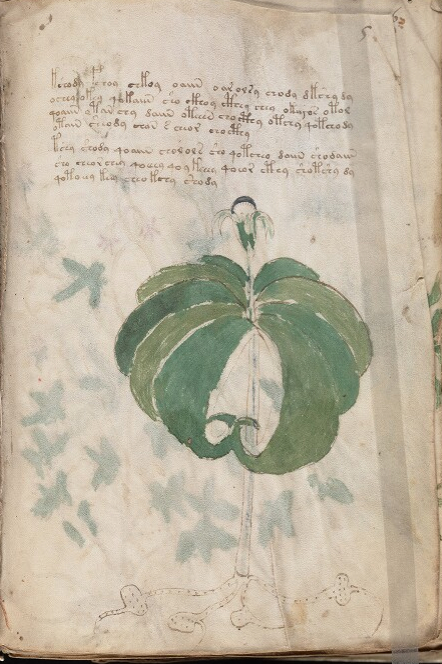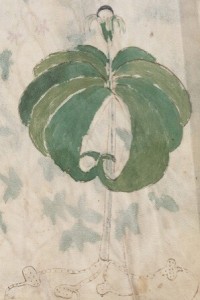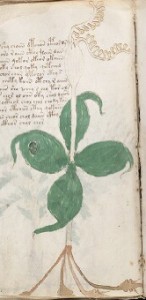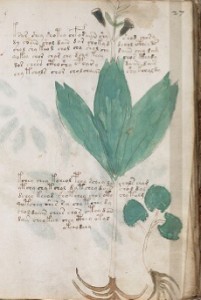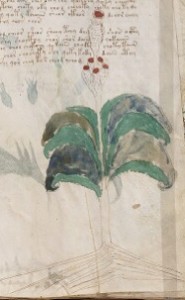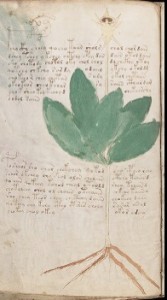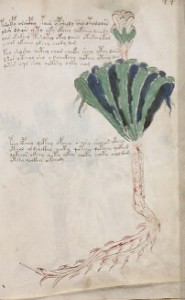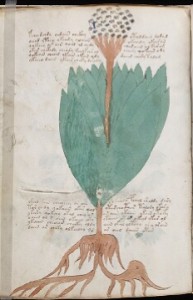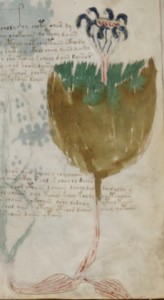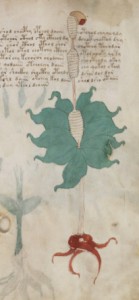Folio 5r consists of two blocks of text followed by a plant picture that reaches almost to the bottom of the page.
The overall shape of Plant 5r is fairly typical of a number of woodland species. It has a long stalk with a whorl of leaves, another shorter length of stalk and a flower, bud, or fruit at the top. There are long sepals extending from the calyx that curve down from what resembles a single berry.
The roots are irregularly shaped with what appear to be modest tubers and extend to the sides like rhizomes.
The leaf whorl consists of about nine leaves and they have been painted alternately green and a slightly lighter green, possibly to help distinguish one from the next. The tips curl under in a manner that might be characteristic of the plant or which might indicate that it’s later in the year, as several plants with this basic structure do tend to curl both in the leaves and the sepals later in the year when the berry or other seed pod is fully ripe.
Prior Identifications
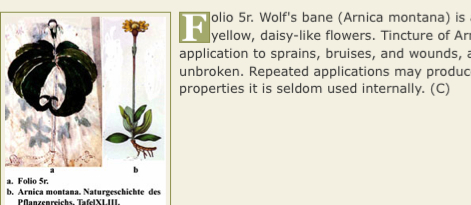 Edith Sherwood has identified 5r as Arnica montana, a flowering plant with elliptical basal leaves, a long stem, and a single yellow flower at the top. However, the VM illustrator has positioned large leaves high on the stem rather than a ground-level whorl of smaller leaves that differs noticeably from A. montana. Also, while Arnica montana frequently has a single stem, it can also branch and put out a flower at the end of each stem. VMS Plant 18r probably better represents Arnica montana (or one of its relatives) than Plant 5r. It seems unlikely that Plant 5r is Arnica montana.
Edith Sherwood has identified 5r as Arnica montana, a flowering plant with elliptical basal leaves, a long stem, and a single yellow flower at the top. However, the VM illustrator has positioned large leaves high on the stem rather than a ground-level whorl of smaller leaves that differs noticeably from A. montana. Also, while Arnica montana frequently has a single stem, it can also branch and put out a flower at the end of each stem. VMS Plant 18r probably better represents Arnica montana (or one of its relatives) than Plant 5r. It seems unlikely that Plant 5r is Arnica montana.
Other Possibillities
There are a number of plants similar to Plant 5r in general arrangement, including Plants 15v, 27r, 29r, 42v, 44r (and possibly 55v, 35r and 28r). The shape of the leaves and their direction vary, as do the shape and number of berries, but they have the single-stalk, stem-whorl-off-the-ground shape in common.
The high stem whorl brings to mind a variety of plants like star flowers, cucumber root, trilliums, bunchberries (dwarf dogwood), and paris. They all have a lower stalk, a whorl of leaves, an upper stalk (usually a little shorter than the lower stalk), and a flower head at the top, often with a berry-shaped fruit forming later in the year. One might include Panax (ginseng) in this group, except that it has branching leaves. Plant 55r may have a short lower stalk and it’s difficult to tell whether Plant 35r has a long lower stalk, or a short stem and a long tap root. Judging by the color the stalk has been painted, it may be short.
It can also be debated whether 28r belongs in this group. At first glance it looks like it might, but the elaborate detailing on the upper “stem” may be part of the flower head and may come immediately out of the leaf whorl, in which case it doesn’t have an upper stalk like the previous examples.
There are also VM plants with the same basic shape as 5r that can be thought of as “double-decker” versions, with two sets of leaves, including 19v and 87r, but it’s important to try to discriminate between double-decker plants and drawings meant to represent plants that put out runners (e.g., strawberry plants). Plant 47r may be an example of a plant with a runner rather than with two tiers of leaves.
It’s tempting to declare that Plant 5r might be Paris, but the European versions of Paris rarely have this many leaves. There are some species of Paris with longer, more numerous leaves, but they tend to grow in Malaysia.
Other Possibilities
Plant 5r has a number of traits similar to star flower, also called Indian potato. Star flower (Trientalis latifolia) has a long stem and a whorl of elliptical leaves, but there are usually only about five leaves, and the stems tend to curve under the leaves when it begins to fruit, and the fruits are small and delicate. Also, star flower has quite a distinctive root, like a thumb, similar to Indian cucumber (an eastern cousin to the star flower), but quite small, and doesn’t match Plant 5r.
Maybe Indian cucumber (Medeola virginiana), a member of the lily family, should be considered. The roots are thumb-shaped and are larger and longer than those of star flower. They grow out sideways and are big enough to be eaten and could somewhat resemble the roots of Plant 5r. Notice that the roots of 5r have not been painted brown or reddish-brown like so many of the other plants. It’s very common for plants of the lily family to have light or white-colored roots, as do those of Indian cucumber. M. virginiana has another trait in common with Plant 5r—a distinctive berry topping the stem above the whorl of leaves.
M. virginiana is a closer match than star flower, but differs from Plant 5r in that it usually has two tiers of leaves and there are no distinctive filaments extending out beyond the fruit. Sometimes the fruits are single, but often there are three or more.
Eranthis cilicica, a Mediterranean plant, doesn’t look like Plant 5r until you dry it, and then the leaves curl under and the fruit sticks straight up above the leaves, but it doesn’t have prominent filaments nor is the fruit round.
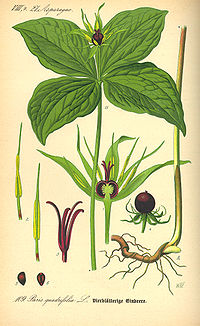 Which brings us to Paris. Paris is actually quite a good match for Plant 5r. It has a whorl of leaves a number of inches from the ground and it forms a berry-like fruit cupped by long sepals. The light-colored root extends to one side.
Which brings us to Paris. Paris is actually quite a good match for Plant 5r. It has a whorl of leaves a number of inches from the ground and it forms a berry-like fruit cupped by long sepals. The light-colored root extends to one side.
Paris quadrifolia, as the name implies, as four leaves but they tend to spread out from the stem rather than curling under. P. quadrifolia is a Eurasian plant that is physically similar to Indian cucumber but belongs to a different family. It’s unusual to find examples of P. quadrifolia with more than four leaves.
Most Paris species don’t grow in Europe. There is a wide variety of these spidery plants known as Paris or Daiswa gracing the forests of Malaysia and northern India, often at higher elevations. Eastern species frequently have between six and nine leaves and many of them have two tiers of leaves. Some form a single berry-like fruit. Others have a ring of smaller fruits that look like the bumps on the end of a hairbrush. Some have a knobby root, others have finer root hairs. Most of them have long slender structures between the fruit and the top whorl of leaves the resembles a calyx (or might be a calyx). Some of them are a good match for Plant 5r but the ones that are closest in terms of roots, leaves, and fruit often have two tiers of leaves, rather than the single whorl of leaves on Plant 5r.
Summary
Since there are several possible candidates for Plant 5r, I’m reluctant to single out any one of them as the most likely just yet but I’m quite certain 5r is not Arnica montana. It’s much more likely that Plant 18r, if it’s not Calendula may be Arnica Montana.
Posted by J.K. Petersen

